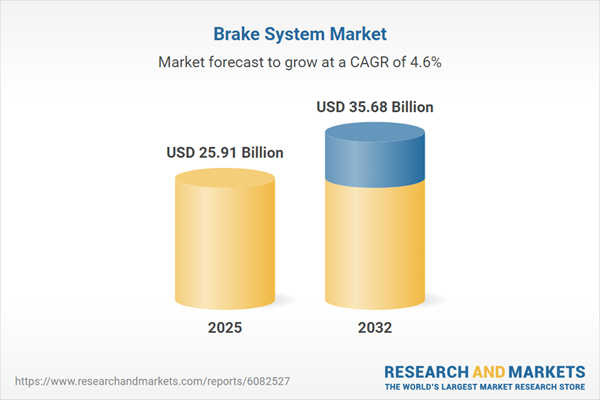Speak directly to the analyst to clarify any post sales queries you may have.
The brake system market is advancing rapidly, as manufacturers and suppliers respond to evolving industry requirements across automotive, industrial, aerospace, and railway sectors. Strategic innovation in actuation methods and material science, paired with regulatory demand for reliability and efficient integration, is driving transformation in this critical component segment.
Market Snapshot: Brake System Market Growth and Dynamics
The Brake System Market grew from USD 24.82 billion in 2024 to USD 25.91 billion in 2025. It is expected to continue growing at a CAGR of 4.64%, reaching USD 35.68 billion by 2032. Growth is shaped by innovation in anti-lock and electronic technologies, expanding use in electric mobility, and ongoing regulatory emphasis on safety and environmental standards across global regions.
Scope & Segmentation of the Brake System Market
This report offers a detailed analysis of the brake system market, providing insights across products, components, technologies, vehicles, end-users, and sales channels, as well as a comprehensive regional breakdown.
- Product Types: Anti-Lock Brake System (ABS), Disc Brakes, Drum Brakes
- Components: Brake Calipers, Brake Drums, Brake Fluid, Brake Linings, Brake Pads, Brake Rotors/Discs, Brake Shoes
- Actuation Methods: Electric, Hydraulic, Mechanical, Pneumatic
- Vehicle Types: Commercial Vehicles (Heavy and Light), Passenger Cars (Hatchback, Sedan, SUV/Crossover), Two-Wheelers
- End-Users: Aerospace, Automotive, Industrial Machinery, Railways
- Sales Channels: Aftermarket, OEM
- Regions: Americas (North America, Latin America), Europe, Middle East & Africa (Europe, Middle East, Africa), Asia-Pacific (China, India, Japan, Australia, South Korea, Indonesia, Thailand, Malaysia, Singapore, Taiwan)
- Key Companies: ZF Friedrichshafen AG, AB Volvo, AKEBONO BRAKE INDUSTRY CO., LTD., Audi AG, Batz Group, Bayerische Motoren Werke AG, Bendix Commercial Vehicle Systems, LLC, BWI Group, Cardolite Corporation, Carlisle Brake & Friction, Continental AG, Endurance Technologies Limited, Haldex AB, Hitachi Automotive Systems, Ltd., Hyundai Motor Company, Kor-Pak Corporation, KSR International Inc., Mando Corporation, Miba AG, ProTech Friction Group, Regal Rexnord Corporation, Robert Bosch GmbH, TE Connectivity Ltd., TMD Friction Holdings GmbH, Trimat Limited, Valeo SA
Key Takeaways for Senior Decision-Makers
- Technological developments such as integration with stability controls, V2X systems, and adaptive control algorithms are reshaping product portfolios and driving operational improvements.
- Stringent regulatory frameworks in major regions require advanced safety and performance benchmarks, influencing component design and durability expectations.
- Regional adoption patterns vary, with North America and Europe focused on advanced electronic systems, Asia-Pacific leading electric mobility, and other markets maintaining demand for cost-effective solutions.
- Supply chain resilience and close collaboration across tiers are critical, as global trade dynamics—including tariffs—impact material sourcing and pricing models.
- Aftermarket channels are leveraging predictive and digital maintenance, adding new dimensions to value-added services and customer engagement.
Tariff Impact on the Brake System Market
Recent US tariffs on steel and aluminum imports have increased pressure on brake system manufacturers by raising raw material costs and prompting sourcing adjustments. Firms are actively diversifying suppliers, pursuing North American partnerships, and investing in localized production to mitigate exposure and maintain operational continuity. Strategic alliances and adoption of advanced manufacturing methods are helping companies remain agile in response to global trade challenges.
Methodology & Data Sources Used in Brake System Market Analysis
This report employs a mixed-method research approach, combining secondary reviews of technical journals and industry publications with insights from in-depth interviews. Triangulation and validation by subject-matter experts ensure reliability and actionable recommendations.
Why This Report Matters for B2B Stakeholders
- Empowers market leaders to identify growth opportunities by segment and region, supporting targeted investment and risk mitigation strategies.
- Enables data-driven decision-making through validated segmentation, trend analysis, and benchmarking against leading competitors.
- Supports strategic innovation by outlining the latest regulatory, technological, and trade considerations impacting supply chain and R&D.
Conclusion
Senior leaders can use this market intelligence to inform investment, innovation, and partnership strategies. Proactive adaptation and collaboration will be essential in capturing long-term value within the evolving brake system industry.
Table of Contents
3. Executive Summary
4. Market Overview
7. Cumulative Impact of Artificial Intelligence 2025
Companies Mentioned
The companies profiled in this Brake System market report include:- ZF Friedrichshafen AG
- AB Volvo
- AKEBONO BRAKE INDUSTRY CO., LTD.
- Audi AG
- Batz Group
- Bayerische Motoren Werke AG
- Bendix Commercial Vehicle Systems, LLC
- BWI Group
- Cardolite Corporation
- Carlisle Brake & Friction
- Continental AG
- Endurance Technologies Limited.
- Haldex AB
- Hitachi Automotive Systems, Ltd.
- Hyundai Motor Company
- Kor-Pak Corporation
- KSR International Inc.
- Mando Corporation
- Miba AG
- ProTech Friction Group
- Regal Rexnord Corporation
- Robert Bosch GmbH
- TE Connectivity Ltd.
- TMD Friction Holdings GmbH
- Trimat Limited
- Valeo SA
Table Information
| Report Attribute | Details |
|---|---|
| No. of Pages | 199 |
| Published | October 2025 |
| Forecast Period | 2025 - 2032 |
| Estimated Market Value ( USD | $ 25.91 Billion |
| Forecasted Market Value ( USD | $ 35.68 Billion |
| Compound Annual Growth Rate | 4.6% |
| Regions Covered | Global |
| No. of Companies Mentioned | 27 |









